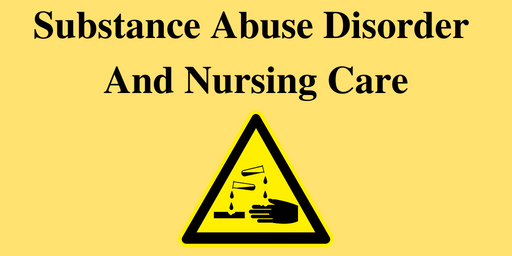The Substance Abuse Disorder And Nursing Care. Substance Abuse Disorder Substance abuse, often referred to as addiction, is a chronic and relapsing condition characterized by the compulsive use of drugs despite harmful consequences.
The Substance Abuse Disorder And Nursing Care
It falls under the category of psychiatric illnesses known as substance-use disorders (American Psychiatric Association [APA], 1994). The most commonly abused substances in the United States, aside from legal substances like alcohol, nicotine, and caffeine, include cocaine (particularly crack), amphetamines, cannabis (marijuana), hallucinogens, inhalants, opioids, phencyclidine (PCP), sedatives, hypnotics, and anxiolytics.
Drug abuse significantly interferes with normal brain function, often producing intense feelings of pleasure or euphoria. However, these substances also lead to long-term changes in brain metabolism and activity, resulting in physical dependence and cravings for more of the drug (National Institute on Drug Abuse [NIDA]).
Social and Economic Impact
The societal costs of drug abuse in the United States are staggering. In 1992, these costs were estimated at approximately $97.7 billion annually, encompassing a wide range of expenditures related to crime, medical care, addiction treatment, social welfare programs, and lost productivity. Of this, $57.3 billion was spent on illicit drug purchases, with cocaine accounting for $38 billion, heroin for $9.6 billion, and marijuana for $7 billion (White House Office of National Drug-Control Policy [ONDCP], 1996).
The impact of substance abuse extends beyond financial costs, significantly affecting social structures and family dynamics. Families often bear the brunt of the consequences, as relationships can deteriorate under the strain of addiction, leading to neglect and abuse, which may further perpetuate cycles of substance use.
Data and Demographics of Drug Abusers
Demographic data indicate that the majority of drug abusers are men. In 1995, there were 874,000 admissions to publicly funded treatment facilities, with men representing 70% and women 30% of admissions. Cocaine was the leading substance for admissions (38.3%), followed by heroin (25.5%) and marijuana (19.1%).
Treatment modalities for substance abuse include behavioral therapies, counseling, psychotherapy, support groups, and family therapy. Pharmacological treatments, such as methadone maintenance for heroin addiction, are also common. Research indicates that comprehensive, longer-term treatment programs tend to yield better outcomes than short-term or minimalist approaches.
Substance abuse among women presents unique challenges. A significant proportion of drug-abusing women—up to 70%—report histories of physical and sexual abuse, and many come from backgrounds where drug and alcohol abuse were prevalent among parents. The complexity of these circumstances makes it difficult for women to seek treatment, as they often fear losing their relationships, financial security, or custody of their children. This cycle of dependency and fear reinforces their low self-esteem and sense of powerlessness, making the decision to seek help particularly daunting.
Preventive Research
Future research in the field of substance abuse must focus on prevention strategies that address the distinct needs of different demographics, including gender and age. This research should encompass a broad spectrum—from school-aged youth to the elderly—to identify effective interventions tailored to specific populations.
Preventive efforts may focus on three major areas: the individual, peer groups, and the broader community. Each of these requires further exploration and theoretical development to understand their impacts on substance abuse.
Genetic research is also providing new insights into addiction, opening up opportunities for innovative approaches to prevention and treatment. As the field evolves, it is vital for emerging scientists to receive training in genetics and its implications for substance abuse disorders.
In terms of treatment, many existing programs face challenges related to dropouts, treatment failures, and relapse. There is an urgent need for the development and testing of new treatment modalities that can cater to the diverse needs of specific subpopulations—whether they be youth, adolescents, adult men, adult women, or elderly individuals.
Conclusion
Substance abuse disorders are complex and multifaceted conditions that require a comprehensive and compassionate approach to care. Nursing professionals play a pivotal role in identifying, treating, and supporting individuals struggling with addiction. By understanding the various aspects of drug abuse—including its social and economic implications, demographic patterns, and the necessity for tailored prevention and treatment strategies—nurses can contribute significantly to improving outcomes for those affected by substance use disorders.
Effective nursing care must be holistic, addressing not only the physical aspects of addiction but also the emotional, social, and psychological dimensions. Collaboration with interdisciplinary teams and engagement with community resources are essential components of a successful treatment strategy. By focusing on preventive research and innovative treatment approaches, the nursing profession can help mitigate the impacts of substance abuse and support individuals in their journey toward recovery.
Read More:
https://nurseseducator.com/didactic-and-dialectic-teaching-rationale-for-team-based-learning/
https://nurseseducator.com/high-fidelity-simulation-use-in-nursing-education/
First NCLEX Exam Center In Pakistan From Lahore (Mall of Lahore) to the Global Nursing
Categories of Journals: W, X, Y and Z Category Journal In Nursing Education
AI in Healthcare Content Creation: A Double-Edged Sword and Scary
Social Links:
https://www.facebook.com/nurseseducator/
https://www.instagram.com/nurseseducator/
